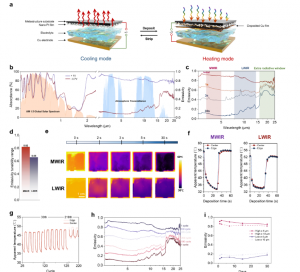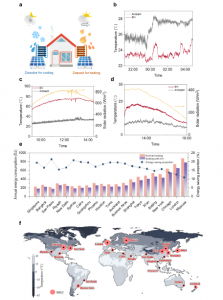Smart Material Puts Thermal Control at The Fingertips
Imagine flipping a switch not to turn on a light—but to shift a building from heating to cooling. A breakthrough in smart materials now makes this possible.
SHANNON, CLARE, IRELAND, June 24, 2025 /EINPresswire.com/ -- https://doi.org/10.1021/acsenergylett.5c01153
Flipping switches to control light and sound is commonplace—but what if buildings could do the same with heat? A newly developed electrochromic harvester now potentially makes that possible. This dynamic surface material can toggle between solar heating and radiative cooling, offering passive, programmable thermal regulation with no sustained power input. Embedded in a building’s water loop system, it offers a scalable, low-energy path to year-round indoor comfort.
The material is built around a 5-nanometer platinum metastructure electrode, which enables reversible copper deposition. This mechanism alters the surface’s infrared emissivity, switching it from a low-emissivity heating mode to a high-emissivity cooling mode. Once activated by a short voltage pulse, the material remains in its chosen state for over 30 days. The transition requires no continuous energy, reducing reliance on electricity-hungry HVAC systems.
To achieve this, researchers used Finite Element Method (FEM) simulations to map thermal cycling and ensure uniform Cu deposition, preventing local overheating or material degradation. Density Functional Theory (DFT) calculations further guided the choice of platinum as the conductive layer, showing optimal adsorption energies and superior ion distribution that support stable bistability and high reflectivity modulation across the mid- and long-wave IR bands.
In testing, the surface raised internal temperatures by up to 45.4°C above ambient in summer heating mode and cooled by 5°C below ambient at night. Simulated deployments across 21 cities globally suggest that annual energy savings of up to 21.4% could be possible, with maximum reductions of 95.8 gigajoules in cold climates like Moscow, Russia.
Looking ahead, this material could transform HVAC strategies across a spectrum of industries. In data centers, it could stabilize internal temperatures without compressors. In remote architecture or off-grid greenhouses, it offers self-regulating thermal envelopes. For smart buildings, it could integrate with sensor-based systems to autonomously adapt to weather, time of day, or occupancy. Its durability, bistability, and spectral selectivity make it a compelling foundation for next-generation, passive energy infrastructure, guided by ongoing DFT and FEM-informed optimization for new substrates and expanded scale.
Article Reference
Wenhao Wang, Long Wang, Shenghao Jin et al. Electrochromic Harvester for All-Day Energy Savings in Buildings, ACS Energy Lett. 2025, 10, 3231–3240, https://doi.org/10.1021/acsenergylett.5c01153
Keywords
Electrochromic energy harvester (EH); Reversible metal electrodeposition (RMED); Photothermal conversion (PT); Radiative cooling (RC); Spectrally selective materials; Infrared emissivity modulation; Midwave infrared (MWIR); Longwave infrared (LWIR); Metastructure electrode; Ultrafine platinum (Pt) film
Morgan Lyons
Compuscript
+353 61 472 743
email us here
Legal Disclaimer:
EIN Presswire provides this news content "as is" without warranty of any kind. We do not accept any responsibility or liability for the accuracy, content, images, videos, licenses, completeness, legality, or reliability of the information contained in this article. If you have any complaints or copyright issues related to this article, kindly contact the author above.



